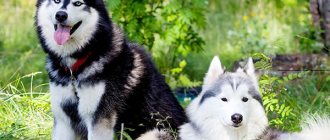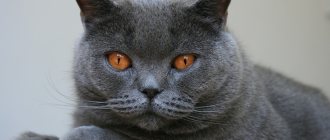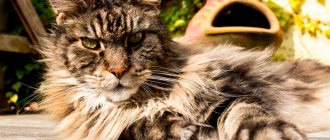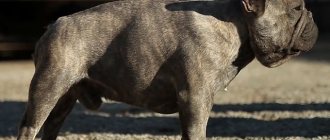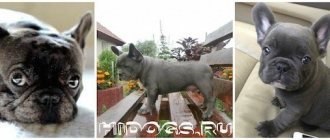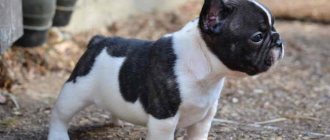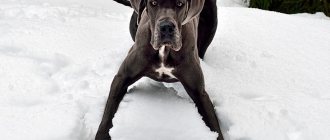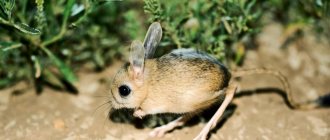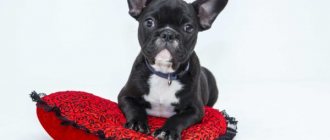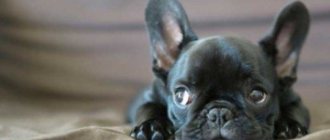| Origin: | France |
| Usage: | companion dog |
| Color: | the most common are mottled, spotted, fawn |
| Dimensions: | height at withers 25-35 cm, weight – 8-14 kg |
| Lifespan: | 11-12 years old |
The French bulldog (aka French) is a fashionable decorative breed. The animal looks quite menacing, but has a cheerful and friendly character, thanks to which it has gained a large number of fans. What a French bulldog is, photos of pets of different stripes, features of keeping and training - further in the article.
Breed standard
FCI breed standard No. 101 describes the dog as a typical Molosser - small, muscular, stocky. Despite the French Bulldog's small size, it appears very strong and impressive. The animal is harmoniously built - no part of the body looks excessively large or small.
Physical parameters:
- height at the withers - males from 27 to 35 cm, females from 24 to 32 cm. The dog may be slightly larger or smaller than the indicated dimensions, but not more than 1 cm;
- The average weight of a French bulldog ranges from 9 to 14 kg, females - 1 kg less. An excess of 0.5 kg is acceptable if other characteristics of the breed are preserved;
- average life expectancy is 10-12 years.
The rather high weight of an adult French Bulldog with its short stature is due to its heavy bones and strong muscles. This feature is characteristic of all bulldog-type animals. After all, the ancestor of this funny little guy is a real fighting dog.
A quick glance at the photo of French bulldogs seems that they are very formidable. But if you look closely, you will see that they have a cute snub-nosed muzzle and funny ears that make them look like bats.
Official French Bulldog Standard:
| Become | Characteristic |
| Head | Large, but proportional to the body. The head is the only part of the body where folds are allowed. The French Bulldog's skull is massive and heavy. The forehead is convex. The stop is clearly visible. |
| Muzzle | Flattened, short and wide, sloping from nose to skull. |
| Eyes | Dark, large, set wide and low, with black rims on the eyelids. The look is interested and expressive, which is noticeable in the photo of the French bulldog. |
| Lobe | Large, pointing upward. The standard allows only black pigmentation. The nostrils are tilted back, but do not interfere with the animal's breathing. |
| Jaws | Powerful, square shaped. The lower one is in front of the upper one. The teeth are hidden behind slightly drooping lips. |
| Ears | Standing, rounded at the ends. They sit high, but not very close. They look strictly straight. |
| Neck | Short, muscular, slightly arched, without dewlap. |
| Torso | The chest is barrel-shaped and deep. When viewed from the front it appears square. The back is strong, rising upward as it approaches the lower back. The abdomen is moderately tucked. The body is slightly stretched - the length is slightly greater than the height at the withers. |
| Tail | Straight, widening towards the base. Small by nature. Located low. French never lifts it above his back. |
| Limbs | Direct. The front ones are slightly turned outward and shorter than the rear ones, so the croup is slightly raised. The paws are small, like a cat's. Fingers are picked up. The claws are painted black. |
French is a short-haired dog. The guard hairs lie tightly to the body and do not bristle. The animal has no undercoat, so it cannot live outside in winter and suffers from the heat in summer.
In the RKF and Europe, only certain color options are allowed. The dominant color is a range from light fawn to red with:
- stripes;
- white spots;
- light speckling.
A black mask is encouraged. A plain French bulldog, photos of which can be found on the Internet, is subject to disqualification. The only permitted color is white, when the skin around the eyes and the lobe remain black. But such animals are not allowed to be bred, since there is a high probability of deaf puppies being born.
French appears energetic and balanced, moving freely and smoothly. He places his paws on his toes like a sophisticated lady walking in high heels.
Breed varieties
Fans don't know what kind of Frenchies there are - only typical representatives of the breed are widespread. However, in fact, Frenchies are divided into 2 types:
- Standard – appearance features are described above.
- The dwarf bulldog is a smaller copy. Weight does not exceed 8 kg, height – 25 cm.
The Dwarf French Bulldog is not recognized as a separate breed, but is considered a deviation from the norm. Sometimes both regular puppies and miniature puppies are born in the same litter. The difference between animals is not only in size, but also in temperament.
Weight and height by month
Many owners are concerned about how much a French bulldog should weigh from birth to full maturity. This is due to the fact that dogs are prone to obesity, but active physical exercise is contraindicated for them. Therefore, people need to control their diet and make sure that their pet does not gain extra pounds.
To understand to what age animals grow and whether their menu requires adjustments, it is worth considering the weight of a French bulldog puppy by month. The table below shows the average parameters.
| Age (month) | Weight, kg) |
| Newborn puppies | 0,2-0,3 |
| 1 | 0,8-1,3 |
| 2 | 2-3,3 |
| 3 | 3,2-5,2 |
| 4 | 4-6,5 |
| 5 | 4,8-7,8 |
| 6 | 5,6-9,1 |
| 7 | 6,4-10,4 |
| 8 | 7-11,5 |
| 9 | 7,5-13 |
| 10-11 | 8-14 |
Over the course of another six months, the puppy grows in width - pumps up its muscles, becomes more massive and stronger.
The height and weight of babies are affected by:
- gender;
- heredity;
- nutrition;
- presence of diseases.
Breastfed puppies grow larger.
A Brief History of Colors
Blue, liver-colored French bulldogs have always existed.
They were described by dog handlers at the end of the 19th century. Soon they began to be rejected. Black and tan colors appeared due to crossbreeding with other breeds, including targeted ones. Fawn dogs have always caused heated debate. This color was common in the breed. In the homeland of French bulldogs, until recently this color was not recognized.
Nowadays the vast majority of fawn dogs have a black mask. They win major shows and produce good offspring.
Some alternative organizations in the United States recognize blue, liver and cream French bulldogs. They are recognized by descriptions in pedigrees. There are nurseries specializing in non-standard colors.
French bulldogs, despite their name, were bred in England. In the 19th century, breeders decided to create a breed of companion dog that could be kept in urban environments without much difficulty. Craftsmen, seamstresses, and lacemakers did not miss the opportunity to acquire a mischievous pet that delighted its owners with its easy-going nature and funny habits.
In the second half of the 19th century, the demand for manual labor decreased greatly due to the rapid development of manufactories. Many English workers moved to France, taking their beloved dogs with them. According to another version, bulldogs were brought here by traders. The good-natured character, ability to catch small rodents and unusually large erect ears instantly attracted the attention of the French public to this breed.
In Paris, the first owners, or rather owners, of small bulldogs were courtesans. There are many photo postcards with naked or semi-naked women posing with their pets. Very quickly, the fashion for these dogs spread in high society, as evidenced by numerous photographs.
French bulldog puppy
French bulldogs made their debut to the general public at an English exhibition in 1896, where they won the admiration of many dog breeders. Breeders became interested in breeding these dogs. The popularity of the breed grew rapidly, and in 1913 about a hundred French bulldogs arrived at the Westminster exhibition.
In the 20s of the twentieth century, these cute pets came to the territory of Russia, but since puppies were very expensive, only representatives of the nobility and simply rich people could afford a French bulldog. One of the most famous fans of French bulldogs was Fyodor Chaliapin. Over time, these dogs' popularity has declined, but they still managed to rank #21 in popularity out of 167 breeds registered by the AKC.
There is a beautiful legend that a French bulldog named Gamin de Pycombe, being the pet of one of the Titanic passengers, managed to escape the shipwreck and even find a new owner. However, this is only half the truth - archival records confirm the presence of a bulldog on board, but it did not survive.
Since the dog was insured, its owner received an impressive compensation of more than 20 thousand dollars. Another representative of the breed who went down in history under sad circumstances was Ortipo, the favorite of Princess Tatyana Nikolaevna (daughter of Nicholas II). The dog died along with its owner during the execution of the royal family.
According to the standard, the colors of the French Bulldog can be divided into uniform and spotted. The uniform color includes brindle and fawn, but dogs with spotted colors have fawn or brindle spots and marks on the main color of the coat. Of course, in addition to this, there may be other types of colors, including rare varieties, but most of them are currently considered by professionals as defects.
Story
Previously, the standard included other colors of French bulldogs; there were even brown, black and blue French bulldogs. Unfortunately, for obvious reasons (lack of necessary equipment, knowledge and skills), they could not previously study this issue in detail. If now it is possible to trace the influence of the gene responsible for the color and other characteristics of the dog, then previously this was impossible.
In addition, purposeful breeding of animals of a certain color was also impossible, so rare colors in this breed could be found completely by chance. Some, of course, tried to achieve results in this field (get a new unusual color) by crossing dogs with close family ties, which, in turn, led to birth defects. This was the factor due to which some colors began to be considered unacceptable, and therefore were excluded from the standard.
Modernity
Unlike early experiments, it is now possible to breed representatives of this breed with a variety of coat colors, while minimizing possible harm to the dog’s health. Although, despite progress in the field of genetics, it is still difficult for scientists to explain the appearance of truly rare and unusual colors, so even now there is a possibility of obtaining a previously unknown color.
For example, to this day there is debate about how dangerous the so-called M gene, which is responsible for the merle color, is, and the list of defects in bulldogs with this gene is quite long. Therefore, sometimes it is better to opt for regular coat colors to ensure your pet lives a long and happy life.
Character
Frenchies have a typical Molosser character - loyal, devoted, noble, but sometimes disobedient and stubborn. During the selection process, they became sociable, cheerful, playful, but retained a tendency towards possessiveness.
Despite his harsh exterior, the Frenchman is very sociable. The dog needs constant communication with its owner. He must understand that he is loved and appreciated. It does not suffer from short-term separation, but patiently waits for the owner's return. The pet subtly senses the mood and does not impose itself if the person wants to be alone.
Frenchies are smart, but they are quite difficult to train. Classes should be short and varied so that the dog does not lose interest. In adolescence, the Frenchman always tests the owner's strength, trying to take a leading position. Pranks must be stopped, but the use of brute force is prohibited. The bulldog will remember the insult for a long time and will do something nasty in response.
The dwarf French bulldog is even cuter and more affectionate. His personality is more like a domestic cat than a dog. This is a real couch animal. Only in exceptional cases does a pet cause trouble - chewing things or furniture. If you surround your baby with care, he will be happy and will not become naughty.
The mini bulldog has average intellectual abilities. He is able to learn the necessary commands, but dogs are not purposefully trained so often - their innate laziness prevents them from being efficient. Some results can be achieved by teaching your child in a playful manner.
Disadvantages and vices
The ICF standard points out the disadvantages:
- Bright specks on brindle and fawn fur;
- White spots on the paws if the dog is solid color;
- Solid fawn individuals have a dark stripe along the back;
- Light claws.
Vices leading to disqualification from the ring and from breeding:
- Not a black nose;
- Heterochromia (different eye colors);
- Black coat with white or tan markings;
- Tanned.
A serious drawback is light eyes and lips. Their color is directly related to coat color.
Socialization
Until 16 weeks, the character of the French Bulldog is soft, like plasticine. During this period, he should be actively socialized, taught basic commands and rules of behavior.
As soon as a small French bulldog appears in the house, he is immediately introduced to the household and allowed to adapt to the unusual environment. The puppy should not feel abandoned. With a lack of attention, Frenchies become fearful or angry.
A French Bulldog and children are sure to make great friends. Only the guys need to immediately explain that the dog is also a member of the family and requires respectful treatment. It is better not to leave children alone with a pet. They may accidentally hurt him, which will force the dog to defend himself.
Difficulties may arise if a child is born in a family where there is a French coat. An insufficiently socialized dog who has not dealt with infants before will be wary of a new little person. In this case, you need to act gently and patiently. It is better for novice dog breeders to contact a zoopsychologist or dog handler. Then the French bulldog and children will definitely find a common language.
The Frenchman has a complex relationship with other four-legged neighbors. You cannot leave your dog with guinea pigs, hamsters, parrots, or rabbits - it will show its predatory nature. A French bulldog and a cat don't always get along either. You need to either get a puppy when the second animal is already in the house, or take both babies at the same time so that they grow up together.
The mini French bulldog is more loyal to pets. However, he is also able to catch a mouse running past. On a walk, a baby can fearlessly bark at a larger dog, and, if necessary, rush to protect the owner.
The socialized Mini French Bulldog enjoys playing with other small breeds. For example, a Chihuahua.
Species of tiger
The French bulldog is widespread among the breed and consists of harmonious inclusions of hairs of red shades on a black background, or black hairs on a red background. There may be a mask on the muzzle (with dark colors it is difficult to distinguish) or a whitish mark, and marks on the chest and throat.
It is interesting that all French bulldogs are fawn, and the coloring of brindle is variegated stripes on its background of varying intensity and size. The lines on the body come in different intensities. There are dogs that are almost black, but this is only visual. There are then some variegated hairs in the fur.
Divided:
- Fawn brindle – variegated stripes on a light background;
- Fawn-variegated – even distribution of brindle and fawn color;
- Heavily mottled - very dark, the main background is practically invisible due to the brindle;
- Reverse tiger is a new term meaning sparse stripes on a light background.
These French bulldogs look very impressive. The sizes of the transverse stripes are different, as is the brightness of the background. They appear on a red, sandy base and may be adjacent to white spots.
Feeding and care
Frenchie is a small breed adapted for living in an apartment. The pet will not be able to live outside. The animal requires minimal care, but due to its tendency to allergies and obesity, it needs a properly selected diet.
Walk
A French bulldog dog will not force its owner to take him for a run every day. In a large house she can live with virtually no walking. Pets are trained to go to the litter box, so they do not cause problems for their owners. But the less the animal moves, the more attention you need to pay to its menu.
You can avoid walking in bad weather. But on clear days it is better to go outside with your pet so that he can frolic and get some fresh air.
Fawn color
According to the standard, fawn color is characterized as a color from pale to dark fawn (from rich red to café au lait); Can be with or without a mask. A small amount of white spots on the animal’s neck, chest, and belly is acceptable.
Fawn is a red color with variations in shades. So for example, when
Type red hairs have dark ends of varying lengths. The dark, grayish tips of the coat are often clearly visible on French Bulldog puppies. Moreover, with age, the ends turn red.
French bulldogs are allowed any shade of fawn. However, some options are considered undesirable. For example, red, closer to bronze, or sable with excessive darkening on the back.
The belly of fawn-colored dogs should be white.
On the main fawn background, transverse black stripes are pronounced.
- There are thin "brindle" stripes throughout the French Bulldog's body, and the fawn coat color is dominant.
- With black streaks, the color is closer to black. In this subtype, the fawn color is recessive.
The color of the coat can vary from soft sand to red. The latter are also called deer. On the extremities, obvious lightening is possible. Previously, this color was considered non-standard, but already in 1994 the International Film Festival allowed it.
French bulldogs with fawn coats were always born in large numbers. With the development of genetics, such colors were no longer considered a sign of impure breeding.
If in distant ancestors pairs of brindle dogs had fawn spots or solid ones, then the puppies can inherit a solid color.
We suggest you read: Training Yorkshire Terriers
Price of puppies
How much a French bulldog costs is determined by the class of the puppy, its pedigree, and parental regalia (prices are indicated in rubles):
- a puppy without a pedigree can easily be purchased for 3-5 thousand. However, you should not be tempted by the low cost of a French bulldog. Such babies are usually born as a result of a casual relationship. There is a high probability that they have hereditary diseases, mental problems or other abnormalities;
- pet-class French bulldog puppies - healthy, but not meeting the color standard - are sold for an average of 20 thousand;
- the breed class is valued higher - from 30 to 40 thousand;
- The most expensive are purebred babies with a pedigree and great exhibition prospects - the so-called show class. Their price reaches 80 thousand in rubles.
In the photo, the French bulldog puppy looks very funny. But you don’t need to be led by emotions and buy the first baby you come across.
The choice depends on the goals being pursued. For those wishing to conquer European exhibitions, French bulldog puppies from the last group are suitable. And those who want to get a loyal and cheerful pet should pay attention to the pet or breed class - the line between them is very thin.
Despite the fact that the mini French bulldog cannot participate in exhibitions, it costs the same as a standard show-class French bulldog. Finding such a puppy is very difficult. Unscrupulous breeders pass off weak and developmentally delayed puppies as dwarf dogs. Therefore, it is better to buy babies when they are older, when the difference in size becomes obvious.
Before choosing a French bulldog puppy, you need to make sure of the health of its parents - meet them in person or at least look at photographs. Frenchies have many hereditary diseases.
Nurseries
There are a large number of nurseries in Russia that breed Frenchies. Purebred puppies can be purchased from:
- Moscow - “Dofbali” https://pitomnikdofbali.ru;
- St. Petersburg - “Bulvest” https://dacota.ucoz.ru.
The nurseries' websites tell you everything about Frenchies: features of the breed and character, nuances of keeping them at home, and photos of the puppies.
Standard colors
The ICF system recognizes two types:
- Solid;
- Spotted.
There are color combinations. For example, dark brindles on a fawn background. It is also customary to distinguish the degree of piebaldity (white spots):
- Limited spotted – white markings on chest, tips of paws;
- Medium spotting - half the coat is white;
- Absorbing spotting - the main background is white, but there are small splashes of color.
We suggest you read: Why does a cat growl, bite and hiss for no reason?
There are dogs with a completely white color, but it is undesirable. Black rims on eyelids and lips are required. The nose should also always be this color.
White coat is the absence of visible pigment in the coat. At the genetic level, she has color. In individuals of this breed with white spots of any size, light speckling is allowed.
These include:
- Blue – gray, mousey solid or spotted color. The nose is lightened, as are the eyes;
- Black – solid and with spots. There is no gene for this color in the breed, so such dogs are mestizos or descendants;
- Tan - against the main background there are markings of a contrasting color - above the eyes, on the cheekbones, under the tail, on the chest and the back of the paws. An example is Rottweilers;
- Liver - brown, with red or red lobes, light-colored eyes;
- Cream – light background with a reddish or pink tint.
Perhaps blue or mouse poses a danger to your pet’s health. It is carried by a gene with a lightening function.
In some breeds (Dobermans), blue and isabella dogs suffer from serious problems with the coat, skin, eyes and immunity, and they have a very short life expectancy. This also includes the merle color, which is very rare in the breed. It is prohibited to crossbreed two such dogs.
Cream individuals do not have a dark mask, only a shadow one, unlike fawn ones. Their nose is usually lightened or depigmented. The lining of the eyelids and lips is also not bright. They are easily confused with fawn dogs, and they are born from parents of a wide variety of colors.
A genetic test will help you find out the true color of a puppy or adult dog. It is necessary if there are doubts before breeding and giving birth to puppies. The result of the study also shows the carriage of hidden genes that did not appear, but can be passed on to offspring.
Interesting facts about the breed
There are a lot of interesting things associated with Frenchies - both funny and not so funny. The most interesting facts:
- Dogs catch mice and rats just as well as cats. Previously, sailors took them with them on voyages, and dockers brought them to the port;
- the miniature Frenchman lives with many Hollywood stars - Leonardo DiCaprio, Malcolm McDowell, Anne Hathaway, Lady Gaga, Denise Richards, Reese Witherspoon, Jason Schwartzman;
- In the family of the last Russian Emperor Nicholas II, there lived a Frenchman named Ortino. He was with the owner at the time of the execution and died with him;
- the French do not know how to swim - their heavy heads pull them to the bottom, and their paws are too short to stay on the surface;
- due to the structural features of the nasal septum, standard Frenchies and mini French bulldogs often snore;
- There is a cafe in Paris called “Le Bouledogue” where the walls are decorated with portraits of bulldogs. Here you can sit with your four-legged pet, and local Frenchies will keep lonely people company;
- the famous fashion designer Yves Saint Laurent adored representatives of this breed. He had 5 dogs, whose names were Muzhik I, Muzhik II, Muzhik III, etc.
The French Bulldog breed is well suited to living at home. This is a wonderful pet for both a large family and a single person. The dog will be a faithful companion for the entire life span allotted to him.
English bulldog
The breed acquired its current name back in the 13th century from the word “bull” (translated from English as bull).
English Bulldogs are very powerful dogs. And if they need something, they are ready to sweep away everything in their path .
CAREFULLY!
In 1835, the breed almost began to disappear, but lovers of these pets saved the bulldogs. They began to take them out more and develop their character.
What about the appearance? Dogs have a muzzle with folds and cheeks. The folds are needed to prevent blood from entering the eyes during the fight. The jaw juts forward and opens the teeth.
The shoulders are broad and the large head creates a squat appearance..
The dog has a small pelvis and a massive head. Because of this shape, English Bulldogs cannot give birth to puppies without the help of a veterinarian.
The puppy cannot pass through the birth canal normally, so veterinarians perform a caesarean section.
Experts advise stocking up on air freshener.
English pets often pass gas.
This is because animals breathe with their mouths open and swallow too much air.
English Bulldogs are not the most gentle dogs, but they are very smart.
They are the national dog of England because... represent courage and strength.
Pet character
Dogs are very loyal and serious.
They are more suitable for those people who will love their pet and give it attention.
Bulldogs love to accompany their owner everywhere.
After 1835, this breed was bred as companion dogs. They tried to develop all the necessary qualities for living with people.
The animals are considered a dominant breed, but behave well and calmly.
They are also very attached to their family, so frequent changes of family are a hard blow for them.
Some bulldogs are great for keeping with children.
NOTE!
Animals know how to show patience not only with small children, but also with older people.
But you shouldn’t buy an English bulldog just so your child can run and play with it all day . The Bulldog is slow and quiet.
This breed has a very interesting and unique character.
As mentioned above, dogs are very smart and intelligent. Their slow reaction to the command is not a negative factor. Before executing the owner’s command, they will think it over carefully. Sometimes they are lazy.
Training and education
The Frenchie is self-centered and touchy, so training and education using the “whip” method is not suitable for him. The owner must train the pet and reward it for its efforts with its favorite treats. The connection “listened to the owner - received a reward” is firmly established in the animal’s psyche. An adult pet will be obedient without the need for additional treats.
You can read more about raising a French Bulldog here.
Whip training is not suitable
They begin to train a dog from the age of one month, as soon as it falls into the hands of the owner. Main areas of training:
- limiting aggression towards other dogs (fighting breeds want to “show themselves” and get into fights with their brothers for no apparent reason);
- limiting aggression towards children;
- obedience to the owner (unquestioning execution of orders should be accompanied by the most delicious treats).
Attention! Achieving absolute obedience of a dog is possible only if you treat him with respect.
Video - French Bulldog Training
You can find out more about the methods and methods of training dogs of various breeds in a special section on our website.
